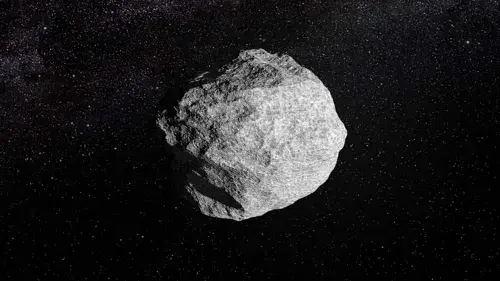Asteroid. In the vastness of space, a celestial dance is constantly underway, with countless asteroids and comets orbiting the Sun. Most pose no threat to us, but every so often, a new discovery captures the attention of planetary defense experts.
Such is the case with asteroid 2024 YR4, a space rock that, while unlikely to hit Earth, presents a unique and intriguing challenge: its potential collision with the Moon.
Asteroid, Shifting Threat.
From Earth to the Moon.
Asteroid 2024 YR4 was first spotted on December 27, 2024, just two days after it zipped by Earth at a distance of about 515,000 miles, roughly twice the distance to the Moon.
While its initial trajectory briefly put it on a list of potentially hazardous objects, further observations by astronomers quickly ruled out an impact with Earth.
The asteroid, estimated to be between 130 and 300 feet (40 to 90 meters) in diameter, is too small to be classified as a “potentially hazardous” object, a category reserved for bodies larger than 150 meters.
Despite the all-clear for Earth, a new concern emerged. As scientists refined their calculations, they discovered that the asteroid’s path brought it dangerously close to the Moon. In fact, there is a small but significant 4% chance that 2024 YR4 could strike the lunar surface on December 22, 2032.
On the surface, this might seem like a relief. An asteroid hitting the Moon is a far better outcome than one hitting Earth. Our atmosphere would protect us from any direct impact, and the Moon’s orbit would not be affected.
However, recent research from NASA and other institutions has revealed a potential hidden danger that could have serious consequences for our space-based infrastructure.
The Problem with Lunar Impacts.
A high-velocity impact of a space rock like 2024 YR4 on the Moon would not be a clean affair. It would blast a massive amount of lunar rock and debris into space. While most of this material would fall back to the Moon, a small fraction would be ejected at high enough speeds to escape lunar gravity.
This is where the problem begins.
This cloud of high-speed debris could travel toward Earth. According to calculations, these fragments could reach near-Earth space within a few days, dramatically increasing the risk of collision with the thousands of satellites and spacecraft that orbit our planet.
Researchers estimate that an impact could increase the risk of damage to these assets by as much as a thousand times, potentially jeopardizing everything from GPS and communication satellites to weather monitoring systems and, most critically, the International Space Station and future lunar gateways.
The Mission to an Unwanted Asteroid.
Given this potential threat, scientists and engineers are now actively exploring options to mitigate the risk posed by 2024 YR4. The consensus is that the asteroid needs to be investigated, and possibly, dealt with.
The first step is a reconnaissance mission. A dedicated probe could be launched to study the asteroid up close, gathering crucial data on its size, mass, composition, and structure.
This information is vital for determining the best course of action. While repurposing an existing mission, such as OSIRIS-APEX (headed for the asteroid Apophis) or the Psyche mission, was considered, the short timeline and lack of fuel for a new trajectory ruled them out.
A new, purpose-built probe is the preferred option, with a potential launch window as early as 2028. Once the data is in, the real debate begins on how to prevent the impact. Two primary methods are on the table:
• Kinetic Impactor: The first option is to use a kinetic impactor, similar to the successful DART mission. In 2022, NASA’s DART spacecraft intentionally collided with the asteroid Dimorphos to demonstrate our ability to alter an asteroid’s trajectory.
While this method worked for Dimorphos, experts warn it might not be suitable for 2024 YR4. A weak impact might not be enough to divert it, while a strong one could shatter it into a few large pieces that could still head toward the Moon or even Earth, creating multiple, equally dangerous targets.
• Nuclear Disruption: The second and more drastic option is to use a nuclear device to completely obliterate the asteroid. The goal is not a direct surface hit, but a detonation at a safe distance around 85 meters from the asteroid’s surface.
This “stand-off” explosion would vaporize or fragment the asteroid into a cloud of harmless meteoroids, effectively turning a single, dangerous rock into a “rain” of dust that would burn up in Earth’s atmosphere. For this to work, the mission would need to be launched no later than late 2031, allowing enough time for the fragments to disperse well before their 2032 rendezvous.
This is a testament to the evolving field of planetary defense. The threat from 2024 YR4 isn’t about saving Earth, but about protecting the vital infrastructure that we depend on every day.
It’s a reminder that in the grand cosmic scheme, our technological lifeline is far more fragile than we might think. And in this case, preventing a lunar impact may be the most critical mission of all.
Have a Great Day!




